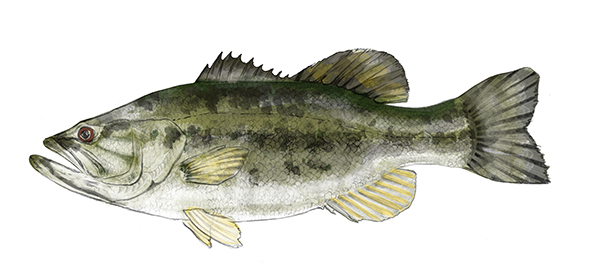Home → Fish & Wildlife → Fisheries → Species Information → Largemouth Bass
Largemouth Bass

Common Name: Largemouth Bass
Other Names: Black Bass, Largemouth
Scientific Name: Micropterus salmoides
Origin: Introduced
Adult Size: The typical largemouth bass in Maine is 12-16 inches long and weigh 1-3 pounds, with occasional fish up to 7-8 pounds.
Identification: Largemouths are dark olive green on the back with light green sides shading to a white belly. A dark mottled band extends along the sides. The upper part of the mouth extends past the eye. Smallmouth bass are similar in appearance, but the upper jaw ends below the eye.
Diet: Bass eat a variety of food items. Juvenile bass eat smaller food items like insects. Adult bass consume a variety of fish, crayfish, frogs, newts, dragonflies, and virtually anything else they can fit in their mouths!
Fishing tips: Bass prefer areas with lots of cover such as woody debris, weed beds, and rocks.
In the spring and summer months, smallmouth bass are found in shallow rocky areas or off rocky drop offs in 5 to 15 feet of water, while their largemouth cousins prefer more vegetative shallow areas or weedy drop offs.
When fishing for bass, you can use spinners, crankbaits, stickbaits, jigs, minnows, and worms.
Interesting Facts: One trait that makes bass so successful is that they protect their nests from predators. After eggs are deposited in the nest, the male bass can spend weeks guarding the eggs and juvenile bass to ensure they are able to venture off on their own.
Bass grow slowly in Maine, but they can live for many years. A trophy bass (20 inches or so) in Maine could be around 20 years old!
Management: Although bass have been in Maine for a long time, they are not a native fish. Bass were first brought to Maine in the late 1800s, when they were seen as not only an important sportfish, but also as a food fish. Bass were originally introduced into a select number of waters, but they are now found throughout southern, central, and eastern Maine. In recent years, bass have been illegally introduced into some northern Maine waters, which has threatened several native fish species. As a result, the Department does not actively manage bass populations in northern Maine, and we allow unlimited harvest with no size restrictions.
In the southern half of Maine, bass are managed as a valued sport fishery. Bass are quite prolific, which can be challenging when you want to grow larger fish. More fish means more competition for food and habitat. Most anglers practice catch and release, so many of our bass populations are quite robust in terms of numbers of fish. In most waters, the Department encourages the legal harvest of smaller bass. This helps by reducing competition, increasing growth for the remaining fish, and protecting large fish that grow very slowly.